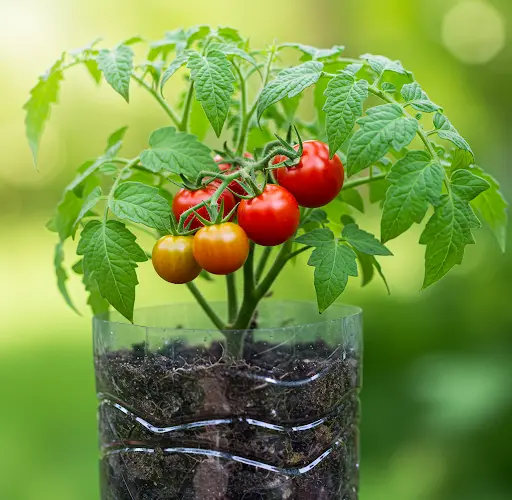How to Grow Tomatoes in Straw for Maximum Fruit Production at Home
Growing tomatoes in straw might sound unconventional, but it’s an effective and efficient way to cultivate an abundant harvest. This method not only conserves moisture but also reduces weed growth and improves soil health. If you want to grow a bountiful crop of tomatoes at home with minimal effort, follow this detailed guide to get started.
1. Choose the Right Tomato Variety
Selecting the right variety is crucial for maximum fruit production. Some of the best tomato types for growing in straw include:
- Indeterminate Varieties: These produce fruit continuously throughout the growing season. Options include Brandywine, Big Boy, and Sweet Million.
- Cherry Tomatoes: These smaller varieties, like Sun Gold and Sweet 100, thrive in straw and yield abundant fruit.
- Roma Tomatoes: Ideal for sauces, these determinate varieties produce a lot of fruit in a short period.
2. Selecting the Right Straw
Straw serves as both a growing medium and mulch, so choosing the right type is essential. Opt for:
- Wheat Straw: A clean, lightweight option that breaks down gradually.
- Barley or Oat Straw: These also work well but may contain some residual seeds.
- Avoid Hay: Hay contains more weed seeds and is not ideal for tomato growth.
3. Preparing the Straw for Planting
Before planting, you need to condition the straw to ensure it decomposes enough to provide nutrients. Follow these steps:
- Soak the Straw Bales: Water thoroughly for about three days to start decomposition.
- Add Fertilizer: Sprinkle a nitrogen-rich organic fertilizer (like blood meal or fish emulsion) to encourage microbial activity.
- Continue Watering: Keep the bales moist for two weeks before planting.
- Check for Decomposition: Once the straw has softened and warmed slightly, it is ready for planting.
4. Planting Tomatoes in Straw
There are two primary ways to grow tomatoes using straw: bale gardening and straw mulch planting.
Straw Bale Gardening
- Create a Hole: Using a trowel, dig a hole in the softened bale.
- Add Compost: Place a handful of compost or potting soil in the hole.
- Insert the Seedling: Carefully place the tomato seedling inside and firm the soil around it.
- Space Properly: Keep at least 18-24 inches between plants for adequate airflow.
Straw Mulch Planting
- Prepare the Soil: Lay a thick layer (4-6 inches) of straw over a garden bed.
- Make Small Holes: Pull back the straw in sections and dig planting holes in the soil.
- Plant the Tomatoes: Place seedlings in the holes, backfill with soil, and cover the surrounding area with straw to retain moisture.
5. Watering Techniques
Tomatoes need consistent moisture to thrive. When using straw, follow these watering tips:
- Water Deeply: Ensure water reaches the roots by soaking the straw thoroughly.
- Monitor Moisture Levels: Stick your hand under the straw; if it feels dry, it’s time to water.
- Use Drip Irrigation: A slow-drip system helps keep the bales and soil evenly moist.
- Morning Watering: This minimizes evaporation and allows leaves to dry, reducing disease risk.
6. Fertilizing for Maximum Yield
Tomatoes grown in straw need additional nutrients to support fruit production. Use these fertilization strategies:
- Early Growth: Apply a nitrogen-rich organic fertilizer to encourage leafy development.
- Flowering and Fruiting: Switch to a phosphorus and potassium-heavy fertilizer to support blooms and fruiting.
- Regular Feeding: Every two to three weeks, apply compost tea, fish emulsion, or a balanced organic fertilizer.
7. Providing Support for Tomato Plants
Since tomatoes grow tall and heavy with fruit, they need proper support. Use:
- Cages or Stakes: Keep plants upright and off the straw surface.
- Trellises: For indeterminate varieties, a trellis system encourages upward growth and better airflow.
- Ties and Clips: Secure plants gently to their supports using soft ties or clips.
8. Pruning for Better Productivity
Pruning helps direct the plant’s energy toward producing more fruit rather than excessive leaves. Here’s what to do:
- Remove Suckers: These small shoots grow in the crotches of branches. Pinching them off ensures the plant focuses on fruiting.
- Trim Lower Leaves: Cut leaves near the base to prevent soil-borne diseases.
- Thin Out Dense Growth: This improves air circulation, reducing disease risk and promoting even ripening.
9. Encouraging Pollination
Tomatoes are self-pollinating, but boosting pollination can lead to higher fruit yields. Try these methods:
- Hand Pollination: Shake the flowers gently or use a small brush to transfer pollen.
- Attract Pollinators: Plant basil, marigolds, or lavender nearby to invite bees and butterflies.
- Air Circulation: Position plants where they benefit from natural wind movement.
10. Preventing Common Tomato Problems
Growing tomatoes in straw can help prevent some common issues, but watch out for:
- Blossom End Rot: Prevent calcium deficiency by ensuring consistent watering and adding crushed eggshells.
- Fungal Diseases: Avoid overhead watering and space plants adequately.
- Pests: Check regularly for aphids, hornworms, and whiteflies. Use neem oil, insecticidal soap, or beneficial insects like ladybugs to control infestations.
11. Harvesting Your Tomatoes
Picking tomatoes at the right time ensures the best flavor. Follow these harvesting tips:
- Look for Full Color: Tomatoes should have deep, vibrant hues according to their variety.
- Check Firmness: They should be slightly soft but not mushy.
- Use a Gentle Twist: To harvest, gently twist and pull the tomato off the vine.
Conclusion
Growing tomatoes in straw is an efficient, sustainable method that leads to high fruit yields with minimal weeding and excellent moisture retention. By choosing the right variety, preparing the straw properly, and providing adequate support and nutrients, you can enjoy an abundant harvest of delicious homegrown tomatoes. Start using these techniques today and experience the benefits of straw-based tomato gardening!



